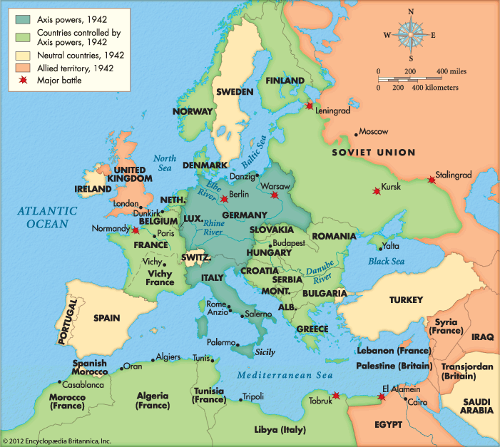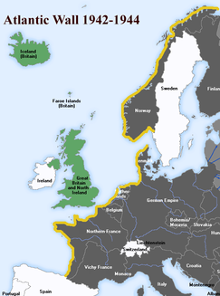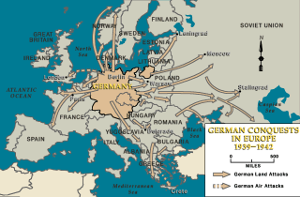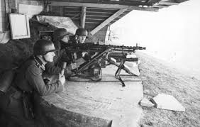Germany's Atlantic Wall
Germany had tried to soften up the United Kingdom, with wave after wave of bombings, as a prelude to an invasion. The U.K. won the Battle of Britain, however, and German leader Adolf Hitler called off the invasion.  German troops were also prevalent in attacks on Allied locations in North Africa. Under Field Marshal Erwin Rommel, Germany had several early successes. In late 1942, however, things began to change. The Soviet Army stopped the German advance at Stalingrad and started to push the Germany Army back. Allied forces in North Africa turned the tables on Rommel and his Afrika Korps, pushing Germany out altogether by May 1943. Soviet forces kept on retaking back parts of their country throughout 1943. Also in that year, Italy, one of the Axis Powers, surrendered to the Allies. After a forceful but relatively brief occupation attempt by Germany, Italy declared war on its onetime ally and Allied troops began liberating various cities in Italy. By early 1944, Soviet troops were in Poland, closing in from the east, as Allied troops were closing in from the south, through Italy. American and British planes had been bombing German cities and positions for several months by this time, but Germany still controlled most of the Continent, in what many historians call Fortress Europe. 
Beginning in 1942, Germany had impressed nearly a million French workers into building a large system of coastal fortifications along the Atlantic coastline of France, especially, but also Belgium, Denmark, Norway, and the Netherlands. The more than 1,500 miles of fortifications took the form of walls, fences, and were punctuated by deadly means of defense such as guns, artillery, and mortars. Overseeing the construction of the Atlantic Wall and its defense were thousands of German troops. Patrolling the Atlantic were a large number of German ships as well. Because of the early success of the German navy in patrolling the Atlantic, Allied attacks targeting the Atlantic Wall were few and far between in the first few years of its existence. As the tide turned more and more in the Allies' favor, German forces prepared for an Allied invasion of Europe. The German high command assigned first Field Marshal Gerd von Rundstedt and then Rommel to reinforce the defenses. The lethality of the defenses was extensive. Rommel, concerned with the ability of Allied air power to disrupt any kind of German counterattack, peppered the Atlantic Wall with reinforced concrete pillboxes housing machine guns and artillery. On the beaches or slightly inland were antitank guns and other obstacles for what was expected to a massive tank Rommel was convinced that another element of any Allied invasion would be a large number gliders and parachutists, and he directed his forces to drive into the ground a large number of sharp-topped wooden poles, intended to snare the aerial machines or even the men flying them. Thus, when the Allies invaded Normandy on June 6, 1944, the defenses they faced were formidable indeed. |
|
Social Studies for Kids
copyright 2002–2025
David White



 The German armed occupation of Europe during World War II began on September 1, 1939, when German boots, tanks, and planes rolled into Poland. With that country quickly defeated, German forces continued their lightning attacks, seizing Denmark and Norway in April 1940. The very next month, Germany forced the surrender of Belgium, Luxembourg, and the Netherlands. In June, German troops occupied Paris, forcing the surrender of France. Germany added Greece and Yugoslavia to the fold in April 1941, and that was the way things stayed in Western Europe for a time because Germany invaded the Soviet Union on June 22.
The German armed occupation of Europe during World War II began on September 1, 1939, when German boots, tanks, and planes rolled into Poland. With that country quickly defeated, German forces continued their lightning attacks, seizing Denmark and Norway in April 1940. The very next month, Germany forced the surrender of Belgium, Luxembourg, and the Netherlands. In June, German troops occupied Paris, forcing the surrender of France. Germany added Greece and Yugoslavia to the fold in April 1941, and that was the way things stayed in Western Europe for a time because Germany invaded the Soviet Union on June 22. deployment. Awaiting any kind of infantry advance were miles and miles of barbed wire and steel girders. Also on the beaches and certainly in the water just offshore were a very large number of mines. Further offshore, Germany reinforced the Channel Islands, which were some of the first to be fortified early in the war. Further inland, German soldiers flooded low-lying areas, with an eye toward bogging down marauding Allied tanks.
deployment. Awaiting any kind of infantry advance were miles and miles of barbed wire and steel girders. Also on the beaches and certainly in the water just offshore were a very large number of mines. Further offshore, Germany reinforced the Channel Islands, which were some of the first to be fortified early in the war. Further inland, German soldiers flooded low-lying areas, with an eye toward bogging down marauding Allied tanks.
